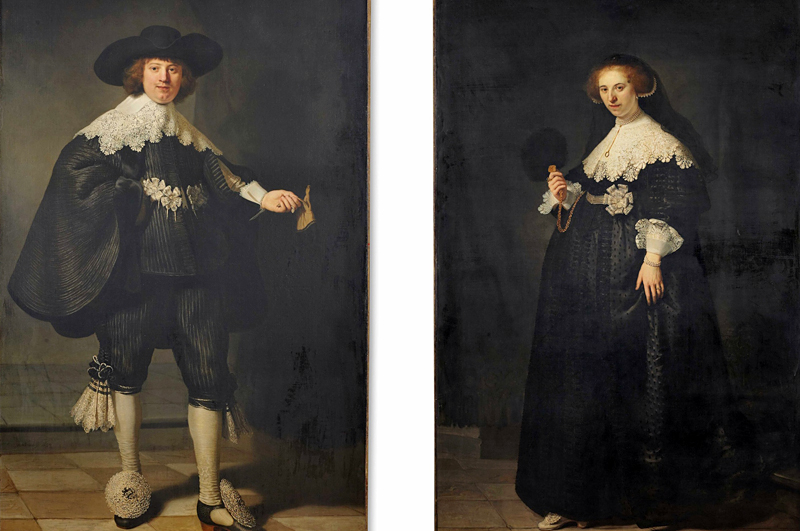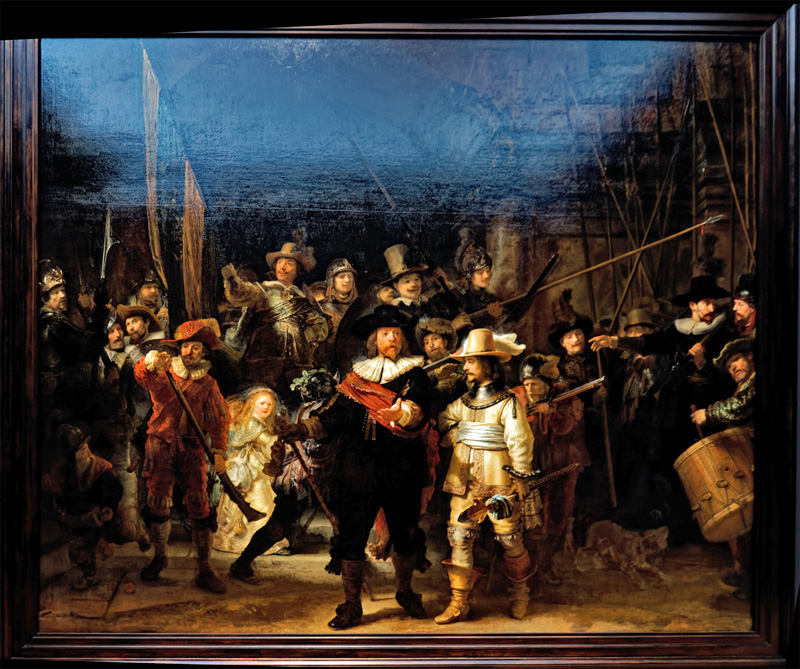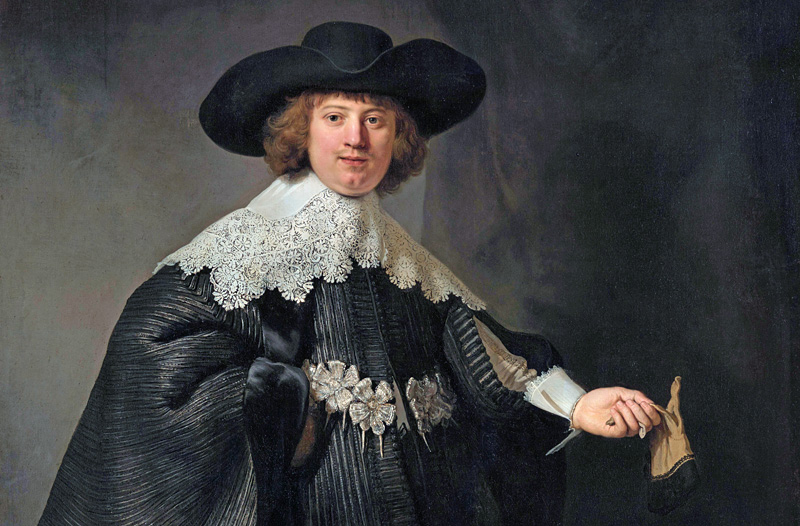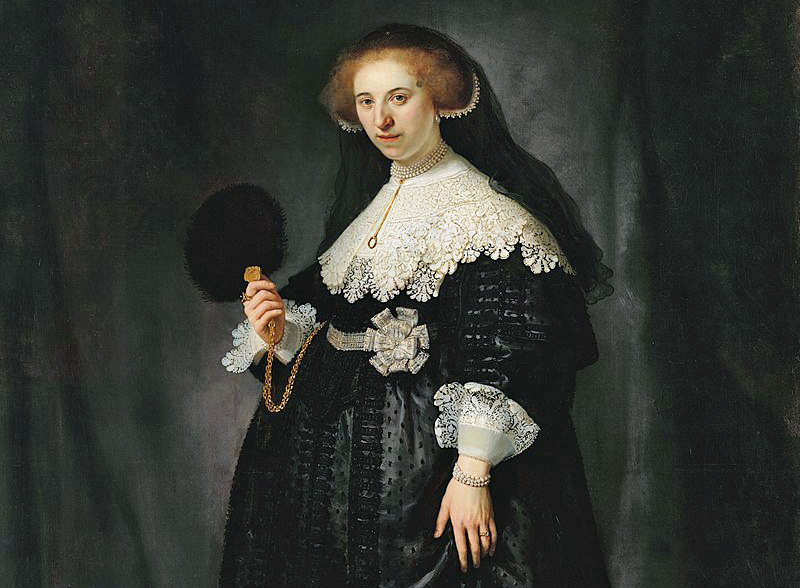Rembrandt as Portrait Painter
In the seventeenth century, in Rembrandt’s time, photography had not yet been invented and when people wanted their likeness taken, they went to a portrait painter, Rembrandt for example. That is exactly what Marten and Oopjen Soolmans did a year after their wedding. Rembrandt painted two separate paintings of the newly-wed. One painting would have been much cheaper, but Marten was clearly a rich man.

Dutch and French Joint Ownership
The Dutch and French governments jointly bought the two paintings of Marten and Oopjen from the French Rothschild family. The portraits had been in private ownership since the nineteenth century and were rarely seen by the public. These two live-seize canvasses were meant to be exhibited alternatively in Amsterdam and in Paris, but are currently still in the Rijksmuseum in Amsterdam.
Rembrandt and Caravaggio
Art School did not exist in the seventeenth century. To become an artist painter, the young man (very rarely young women) apprenticed with an independent master painter, and that is exactly what Rembrandt did. His first master was Jacob van Swanenburgh who had lived and worked in Italy for some time. He introduced Rembrandt to the works of Michelangelo and Caravaggio.
Rembrandt and ‘Chiaroscuro’
Rembrandt’s second master was Pieter Lastman who was also inspired by Caravaggio. Both Van Swanenburgh and Lastman were impressed by the ‘chiaroscuro’, the dramatic light-dark contrast, that characterizes Caravaggio’s work and that Rembrandt made so famous.

Master and Disciple
An apprentice painter helped his master by painting parts that did not require the stroke of the master. An apprentice would paint in the less demanding details like the background, the trees or the flowers in the grass. He would also make copies of paintings that were in demand in order to sell multiple canvasses. The aspiring painter also learned how to mix pigments to obtain the right colour paint.
Practice Makes Perfect
It was common practice for portrait and painters of other genres to have all kinds of objects in their studios: exotic shells, goose feathers, goblets, but also brocade, velvet and finely knotted lace. All of these were used as examples and meticulously copied as an exercise. The painter also had to understand anatomy as the figures he depicted should look natural and not have arms or hands at a physically impossible angle.

Marten and Oopjen Commissioned Rembrandt
After becoming a master painter, Rembrandt engaged apprentice painters who could do the routine jobs so that the master himself could refine his style. Early in his career, Rembrandt painted a whole series of self-portraits to master facial expressions. This helped him to become a well-known and sought after portrait painter. Slowly but surely he received one commission after another.
In 1642, a year after their wedding, Marten and Oopjen Soolmans turned to Rembrandt with the request to have themselves portrayed by the then 28-year-old painter. The couple were quite well off and the two portraits shows luxury, wealth and refinement.
Marten
Marten looks at us in a confident manner, from beneath his flamboyant hat. The flat collar and the glove in his hand are the fashion items of those days. Today he would have had a smart phone or an iPad in his hand. The silver trimmings on his silk stockings and the gigantic rosettes on his high-heeled shoes were also sensational and the latest fashion all young men wanted to have.

Oopjen
Oopjen’s dress and large bobbin lace collar, the hairstyle, the feather fan and the black veil show a very fashion-conscious young woman. A mouche on her temple accentuates her light skin. On her right index finger she wears a gold ring with a black stone and on her other hand a ring with a diamond and a pearl necklace with a gold pendant adorns her neck. All these were fahionable and expensives jewelry.
Rembrandt and Marten and Oopjen
Rembrandt shows his master-skills in the portraits of Marten and Oopjen: the detailed lace collars are painted lifelike as if you could touch them, the folds in the clothing, the structure of the fabric, the shine on the silk stockings and the radiant pearls. This work is, as it were, Rembrandt’s signature. This technically perfect and prestigious work was most likely the start of a series of important commissions, culminating in the commission of Frans Banninck de Cocq’s company, better known as the Night Watch.
Marten and Oopjen in the Rijksmuseum
Marten and Oopjen were jointly purchased by the Dutch and French Governments in 2016 for €160 million and have been on display in the Rijksmuseum in Amsterdam since that year.
The original plan was that the paintings would be on view alternatively for five years in the Rijksmuseum in Amsterdam and then for five years in the Louvre in Paris. However, the Rijksmuseum still has the portraits on loan from the Dutch and French governments, and no end date has been set for the exhibition.
Location
The two paintings are exhibited in the Gallery of Heroes in the Rijksmuseum
Address: Rijksmuseum, Museumstraat 1, Amsterdam
Opening hours: all year, every day from 09.00-17.00
Free entry with I Amsterdam City Card
NOTE
* All visitors are required to book a time slot (also when you have a museum pass or I Amsterdam City Card)
* No time limit to your visit
* Inside the museum payment by pin or credit card only
Next article: Van Gogh Museum
Pevious article: Hash, Marijuana and Hemp Museum



